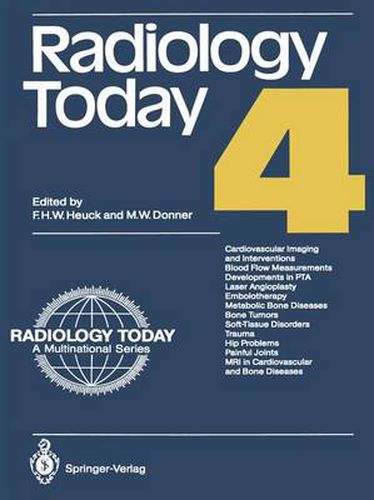Readings Newsletter
Become a Readings Member to make your shopping experience even easier.
Sign in or sign up for free!
You’re not far away from qualifying for FREE standard shipping within Australia
You’ve qualified for FREE standard shipping within Australia
The cart is loading…






This title is printed to order. This book may have been self-published. If so, we cannot guarantee the quality of the content. In the main most books will have gone through the editing process however some may not. We therefore suggest that you be aware of this before ordering this book. If in doubt check either the author or publisher’s details as we are unable to accept any returns unless they are faulty. Please contact us if you have any questions.
The biennial symposium ‘Radiology Today’ continues its original mission to bring together European and American radiologists to discuss advances in the field. This volume presents material by well-known experts in cardiovascular and skeletal radiology. Its aim is to provide an overview of each major topic, trends in clinical development, and current interests in research. The future holds much promise for cardiovascular and skeletal radiology, primarily because of new techniques and procedures, but also because of the development of imaginative approaches to clinical problems. Ideas are born on both sides of the Atlantic, and we believe that it is important to ensure a rapid exchange of new information and to determine how it fits into today’s medical care, keeping in mind the quality of patients’ care, their safety and comfort, as well as cost. The traditional role of radiologists as consultants has increased greatly over time, with new responsibilities being continuously added. We radiologists are challenged to determine the diagnostic pathway appropriate to each patient. To arrive at the diagnosis quickly, safely, and at the lowest possible cost is as important as our participation in determining the patient’s management. Some therapeutic procedures are even carried out by diagnostic radiol ogists themselves, employing ultrasound, computed tomography, or fluoroscopy and intracavitary catheters. Abscesses can be drained, and blood vessels dilated or blocked. In diagnosis and therapy, events are moving quickly, and advances are made at a rapid pace.
$9.00 standard shipping within Australia
FREE standard shipping within Australia for orders over $100.00
Express & International shipping calculated at checkout
This title is printed to order. This book may have been self-published. If so, we cannot guarantee the quality of the content. In the main most books will have gone through the editing process however some may not. We therefore suggest that you be aware of this before ordering this book. If in doubt check either the author or publisher’s details as we are unable to accept any returns unless they are faulty. Please contact us if you have any questions.
The biennial symposium ‘Radiology Today’ continues its original mission to bring together European and American radiologists to discuss advances in the field. This volume presents material by well-known experts in cardiovascular and skeletal radiology. Its aim is to provide an overview of each major topic, trends in clinical development, and current interests in research. The future holds much promise for cardiovascular and skeletal radiology, primarily because of new techniques and procedures, but also because of the development of imaginative approaches to clinical problems. Ideas are born on both sides of the Atlantic, and we believe that it is important to ensure a rapid exchange of new information and to determine how it fits into today’s medical care, keeping in mind the quality of patients’ care, their safety and comfort, as well as cost. The traditional role of radiologists as consultants has increased greatly over time, with new responsibilities being continuously added. We radiologists are challenged to determine the diagnostic pathway appropriate to each patient. To arrive at the diagnosis quickly, safely, and at the lowest possible cost is as important as our participation in determining the patient’s management. Some therapeutic procedures are even carried out by diagnostic radiol ogists themselves, employing ultrasound, computed tomography, or fluoroscopy and intracavitary catheters. Abscesses can be drained, and blood vessels dilated or blocked. In diagnosis and therapy, events are moving quickly, and advances are made at a rapid pace.